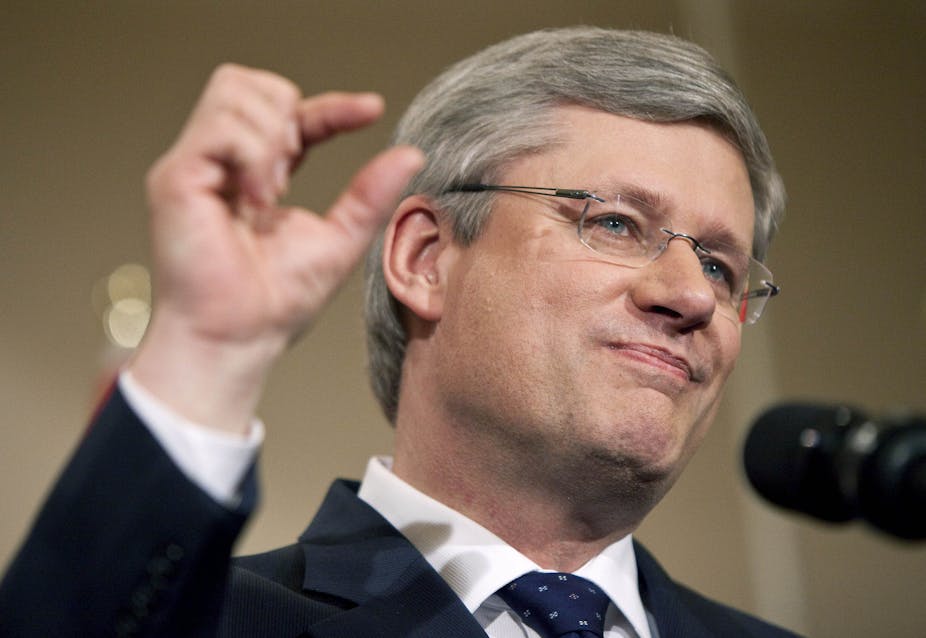Recent Canadian elections have produced minority governments. Until now.
Stephen Harper’s victory in the polls last week fundamentally changed Canadian politics. Majority government is back and it is Conservative: despite the left of centre parties gaining well over 50 per cent of the vote.
Australia and Canada resemble one another in a number of ways, institutionally in terms of being constitutional monarchies and economically in terms of their heavy dependence on commodity exports.
The Canadian election results suggest some interesting political comparisons.
Mired in minorities
Canada’s unhappy experience – three minority governments in a row, each lasting about half the parliamentary term - is over, at least for now.
The elections of 2004, 2006, and 2008 produced one Liberal and two Conservative minority governments, each hamstrung by political uncertainty.
This election finally gave the Conservatives a comfortable majority and provided Canada with a national government capable of addressing serious policy issues.
Canada’s long road to political certainty reminds us of a few truths about minority governments.
They are common in some parliamentary systems (half of Canada’s elections since 1960 have produced minority governments), are associated with the rise of significant third parties, are usually short-lived, and are seldom able to carry out significant reforms.
The rise of the west - sound familiar?
Canada’s two-speed economy has effectively shifted political power to the source of economic power, the resource-rich west.
The west has provided the base for a revamped Conservative Party, but an insufficient number of seats to create a majority government.
This election produced a significant modification of regional tensions within Canada.
The Bloc Quebecois, a secessionist viper based in the French speaking province of Quebec, came within a whisker of succeeding in removing Quebec (a quarter of the nation’s population) from Canada in 1995.
The Bloc was buried in this election, losing 45 of its 49 seats, including that of the party’s leader.
The Conservative Party achieved its victory by expanding from its base in the resource-rich west to win a majority in seat-rich Ontario, Canada’s largest province (106 seats) but suffering from a declining manufacturing base.
Substitute New South Wales for Ontario and West Australia for the Canadian west and one has an interesting Australian parallel.
A Liberal thrashing
The Liberal party, a moderate left party and the grand-daddy of Canadian political parties, tracing its roots back to a nineteenth century alliance of British reformers and anticlerical Francophones in Quebec, collapsed in this election.
Long considered the natural government for Canada and always either that or the official opposition, the Liberals now hold only 34 seats in the 308 member Commons.
The Liberals’ descent from majority party status only a decade ago has been a mechanical ratcheting downwards, losing on average 35 seats in each of the last four elections.
The ascent of the NDP
That decline has been associated with the rise of the New Democratic Party, a left wing party which under the engaging Jack Layton was the big winner in this election (from 37 to 102 seats).
The NDP, till now a very minor player in Canadian national politics, is now a truly national party and appropriately the opposition party in the Commons.
The NDP effectively replaced the Bloc Quebecois in Quebec and expanded its seats almost everywhere else.
They had plenty of help: an inept and tone-deaf Liberal leader (and sometimes Harvard professor who lost his seat in the bloodbath) and the final expiry of the Francophone secessionist fantasy.
But the NDP also won because it effectively wedged the Liberals on ideological grounds, leaving them a weak alternative to a rising conservative force, perhaps a parallel with the Australian Greens’ aspiration with regard to the ALP.
The flight from carbon pledges
Finally, this Canadian election saw a consistent policy shift across all parties on carbon emission policy, with each player moving one step away from a commitment to a significant legislative outcome.
In 2008 the Conservatives, responding to President Obama’s election and his call for tough greenhouse gas reduction targets, pledged participation in a North American cap and trade system.
In 2011, recognizing the disappearance of any substantive commitment south of the border, the Conservatives pledged only to follow American reduction targets.
The Liberals abandoned their 2008 policy of a broad-based carbon tax and means tested energy tax credits, in favor of a cap-and trade-system.
The NDP also lost interest in a carbon tax, promising instead to introduce a high carbon price ($45/tonne) and a narrow cap-and trade scheme.
Post-election Canada has only one commitment to a large scale consumer-based carbon tax – British Columbia’s scheme, introduced by a Liberal provincial government in 2008.
Its fate will now be a matter of increased interest, and speculation.
Shuffling the deck
In political and policy terms, the 2011 election shuffled the Canadian political and policy deck. It will force the nation’s oldest party to either re-invent itself (as the Conservatives did after a devastating defeat in 1993) or disappear.
It produced less ambitious greenhouse gas policies from all parties and ensured that Canada would not move ahead of the US in terms of emissions policies for at least the next four years.
All in all, pretty significant results for a single election.
The bonus is that it may provide a comparative prism through which to contemplate another federal constitutional monarchy, geographically far removed, but sharing similar political and policy dynamics.

